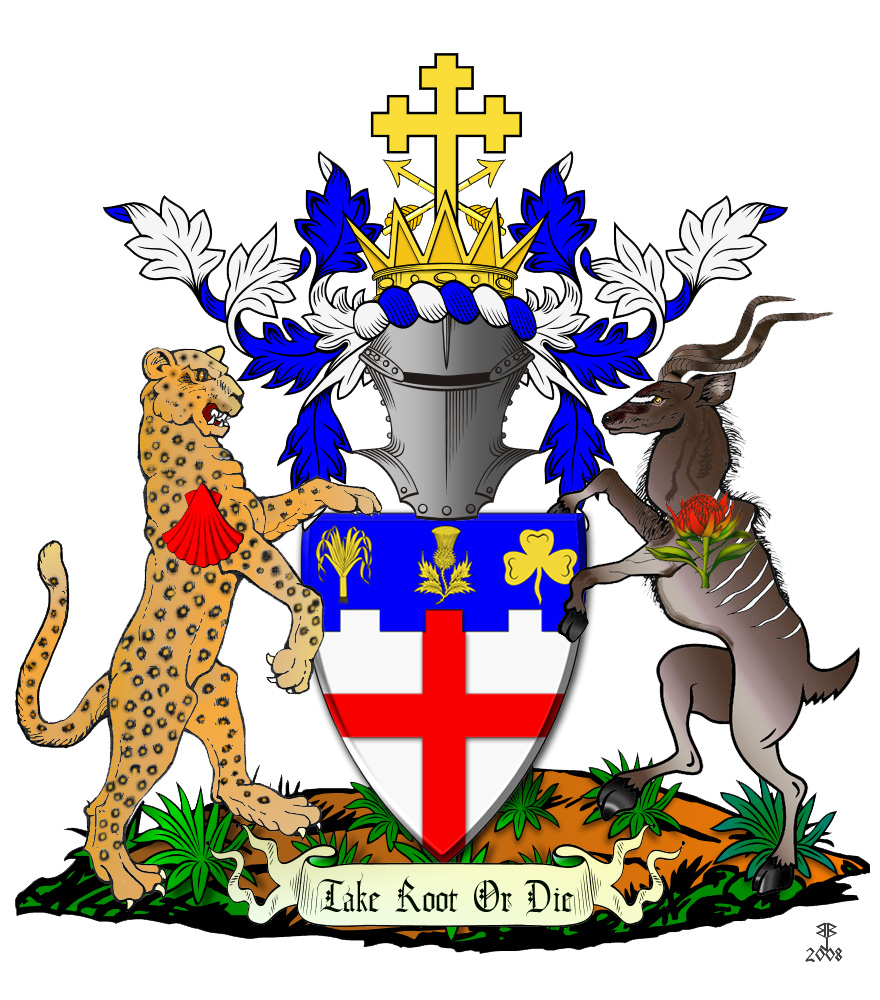

ALBANY DIVISIONAL COUNCIL / AFDELINGSRAAD ALBANY
Province/state: Cape Province, previously Cape Colony (now Eastern Cape).
Incorporated: into Dias Divisional Council, 1980 (later Algoa Regional Services Council, Western District Council, Cacadu District Council).

Arms registered by the State Herald, 30 April 1976:
Arms: Argent, a cross Gules, on a chief embattled Azure a thistle slipped and leaved between dexter a leek eradicated and sinister a leaf of shamrock
slipped Or.
Crest: Issuant from an Eastern crown a cross crosslet fitchy in front of two arrows in saltire Or.
Wreath and mantling: Argent and Azure.
Supporters: Dexter a leopard proper charged on the shoulder with an escallop Gules and sinister a kudu charged on the shoulder with a protea flower slipped and leaved proper.
Special compartment: A representation of the sourveld of the Albany area.
Motto: Take root or die.
About the division:
The eastern region of the Uitenhage district, known as the Zuurveld, was on 7 January 1814 formally named Albany. It is a matter of dispute whether it was named for Frederick Augustus (1763-1827), Duke of York and Duke of Albany, who had been British Commander-in-Chief during the Napoleonic Wars, or for the city of Albany, New York, birthplace of Col Jacob Glen Cuyler, a Dutch-speaking United Empire Loyalist and first British landdrost of Uitenhage. But since both Albany and New York were named after James, Duke of York and Albany (1633-1701, king as James II until 1688), there is a definite link to the Scottish royal dukedom.
The Albany Divisional Council came into being in 1855, following the passage of the Divisional Councils Act, but did not apply for a coat of arms until after the passage of the Heraldry Act of 1962.
The Albany Division was divided in 1857, the Bathurst district, also known as Lower Albany, becoming a separate division with its seat in Port Alfred.
Symbolism in the arms:
The arms symbolise Albany as the centre of British, and especially English, settlement during and after the settlement scheme of 1820 – Grahamstown, the district seat, is dominated by the 1820 Settlers National Monument, a conference centre on Gunfire Hill, overlooking the valley in which most of the city lies.
The central device on the shield is the cross of St George, patron saint of England – the red cross on white is the royal badge flag for England.
In chief are the floral emblems of Wales (leek), Scotland (thistle) and Ireland (shamrock) – also royal badges. The embattled line of partition symbolises the settlement’s military role, as a barrier against invasion from across the Fish River by the amaXhosa.
In the crest, the oriental crown symbolises the eastern frontier of the Cape Colony (as it was in the first half of the 19th century), the cross the planting of the Christian faith, and the arrows again the military function of the settlement.
The dexter supporter, a natural leopard, is taken from the arms of the City of Grahamstown, complete with the scallop shell on its shoulder. The leopard has long been a symbol of Albany, and also appears in the badge of the local Highland regiment, First City.
The sinister supporter, a kudu, is typical of the game once common in the district and (in recent years) again to be found in reserves and on game farms.
The protea symbolises both South Africa (the giant or king protea, Protea cynaroides, is the national flower) and the fynbos vegetation of the Cape Floral Kingdom, of which Albany is the eastern limit. The Albany area known as Beggars Bush is the easternmost site in which P cynaroides is found in nature; it occurs as far west as Cape Town.
The compartment is a representation of the characteristic sourveld which gave the area its Dutch name.
The motto is taken from a remark made in the diary of an 1820 Settler, the Rev Henry Dugmore, who wrote: “It was a forlorn-looking plight in which we found ourselves, when the Dutch waggoners had emptied us and our luggage on to the greensward, and left us with our boxes and bundles ‘under the firmament of heaven’. Our roughly-kind carriers seemed, as they wished us goodbye, to wonder what would become of us. There we were in the wilderness; and when they were gone we had no means of following, had we wished to do so. We must take root and grow, or die where we stood.”
The phrase was taken up by poet and playwright Guy Butler, a professor at Rhodes University, Grahamstown, in his 1966 play Take Root or Die, based on the experiences of the 1820 Settlers.
Dugmore was a nine-year-old boy when he landed as a member of the Gardner party of 1820 Settlers.

Source: image by Barrie Burr.
Comments, queries: Mike Oettle